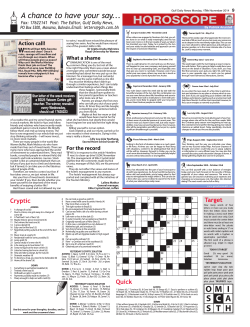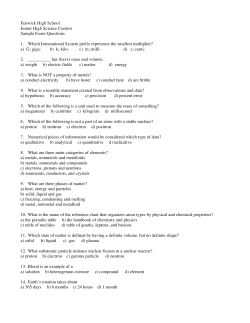
ECONOMICS UPDATE WORKSHEET
Name: Economics Date: BLIZZARD BAG 3 ACTIVITY Case Study Update: An updated article, worksheet, and lesson plan for the Case Study. Fueling Automobile Demand At GM, Lutz's Bets Starting to Pay Off by David Welch and David Kiley Reprinted from the March 2, 2007 issue of Business Week by special permission, copyright © 2007 by The McGraw-Hill Companies, Inc. In an otherwise bleak month for Detroit's carmakers, General Motors (GM) had a strong month powered by a big boost from its rekindled Saturn division. The long-starved Saturn brand saw sales rise 60%, helping GM post a 3.5% gain in a flat car market. New models like the Saturn Aura midsize sedan—voted the North American Car of the Year in January—and the Outlook crossover sport-utility vehicle seem to be winning converts. And there are signs that import buyers will give the brand a look. Growth at Saturn is a sign that GM Vice-Chairman Robert Lutz's new cars are starting to gain traction with consumers. "Saturn finally has some new cars to sell," says longtime industry watcher Mary Ann Keller, who does consulting work and sits on the board of dealer Lithia Automotive (LAD). "They always had good dealers; it was just a question of getting product." Detroit Rivals Falter Make no mistake, GM's problems are far from solved. Sales are down more than 6% so far this year. And the boost in February, when retail sales rose 11% for GM, was helped in part by 0% financing deals offered in the middle of the month. While GM had a pretty strong month, its crosstown rivals Ford Motor (F) and DaimlerChrysler's (DCX) Chrysler Group both took a hit. Ford's sales fell 13% and Chrysler's were off 8%. Meanwhile, Toyota (TM) keeps surging ahead with a 12% jump—record sales for February. Honda (HMC) sales rose 3%. Kia was up 13.5%. Mitsubishi was up 22%. Audi was up 37%. BMW was up 15%. Growth from Saturn could be a big boost for GM. The brand took the U.S. by storm when it was launched in the early 1990s with just one model, the S-series compact. Buyers loved the no-haggle pricing strategy and folksy, friendly dealers. But years of neglect and a weak midsize sedan, the failed L-series launched in 1998, kept the brand from realizing its potential. Blizzard Bag 3: Economics p. 1 Name: Economics Date: Running with the Imports Lutz has long said that Saturn was GM's best bet to win import owners, so he gave the brand the Sky roadster and Aura last year, as well as the Outlook, in a play to win market share back from the likes of Honda, Toyota, and Nissan (NSANY). Soon enough, Saturn will replace the woeful Ion compact with the Astra, the popular compact sold in Europe by GM's German Opel brand (see BusinessWeek.com, 12/14/06, "For Saturn, the Time Is Now"). Edmunds.com says that of the top 10 vehicles cross-shopped by Saturn buyers across the brand's lineup, nearly all of them are import nameplates. No other GM brand comes close to that level of cross-consideration. Conversely, says online car shopping site Edmunds.com, Saturn is seeing huge spikes in reverse cross-shopping as well; that is, shoppers who had Honda, Nissan, Toyota, and Volkswagen on their lists but decided to look at a Saturn model as well. Saturn reports double- and triple-digit increases in reverse cross-shopping figures with the new vehicles it has launched. Saturn is also doing well on the West Coast, traditionally hostile territory for domestic brands. Saturn says its No. 1 dealer in February, based on sales volume, was in Los Angeles. Four of the top 10 Saturn dealers are in the L.A. area. On the Shopping List But Saturn's total sales volume is still relatively small when compared to GM's breadand-butter Chevrolet division. Chevy sold 187,000 vehicles last month to Saturn's 22,000. But Saturn sells mostly to retail customers, as opposed to other GM passenger car brands that do significant business with rental agencies and corporate fleet customers. GM is working to reduce its reliance on low-margin rental car sales. Paul Ballew, GM's executive director of global market and industry analysis, said GM cut fleet sales by 15,000 vehicles in February as the company tries to focus on selling higher-priced cars to retail customers. Though Saturn's numbers are small—just 1,900 Outlooks and 3,800 Aura sedans sold in February—there are reasons for Saturn to be optimistic. Edmunds.com tracks what buyers look at when shopping for a new car. Aura buyers most commonly shop the Toyota Camry, Honda Accord, and Nissan Altima, an indicator that at the very least, Saturn is doing a pretty good job of keeping some of its shoppers from defecting to Japanese family cars. Similarly, the Outlook, which hit the market late last year, gets looks from import shoppers. About one-quarter of Outlook buyers look at its stablemate, the GMC Acadia, but the next two models on their shopping list are the Mazda CX-9 and Honda Pilot crossover SUVs. Blizzard Bag 3: Economics p. 2 Name: Economics Date: Back to Branding Saturn was once GM's brightest light when it came to advertising. The brand, however, dimmed the last five years as Saturn ads lurched from campaign to campaign and slogan to slogan. Last month, though, Saturn General Manager Jill Ladjiak fired agency Goodby, Silverstein & Partners, San Francisco, and hired Deutsch/LA, which aired its first Saturn work during this week's Academy Awards telecast. The ad showed Saturn Aura owners who bought their cars before the car was named North American Car of the Year, opening up a box containing the actual award. Deutsch had the idea that owners should house the award like National Hockey League players on the championship team each get to take turns housing the Stanley Cup. When one Saturn owner is through, he or she mails it to another. Saturn's brand strength has long been in its dealer service and the sense of community Saturn owners have felt since the brand was launched as "A Different Kind of Car Company." The new ad strategy seems to be to foster that part of the brand again without being folksy or old-fashioned. For Saturn and GM, the challenge will be maintaining momentum. Ballew says he expects some heavy competition and, as a result, higher incentives from other carmakers. But at least Saturn is off to a good start. Blizzard Bag 3: Economics p. 3 Name: Economics Date: Case Study: Fueling Automobile Demand Article title At GM, Lutz’s Bets Starting to Pay Off Source BusinessWeek, March 2, 2007 Activate Prior Knowledge Complete the table with the terms below. low margin retail no-haggle pricing Category type of incentive types of automobile customers import buyers fleet cross-shop Example and people who purchase Kias amounts of profit gained from sales to look at Toyota Camrys as well as Saturn Auras Guided Reading Questions Read these questions before you read the article and take notes as you read. 1. Which cars accounted in the rise in General Motors sales? ___________________________________________________________________________________ ___________________________________________________________________________________ ___________________________________________________________________________________ 2. How did the automobile sales of U.S. manufacturers compare with those of foreign companies? ___________________________________________________________________________________ ___________________________________________________________________________________ ___________________________________________________________________________________ Discussion Questions Answer these questions on a separate piece of paper. 1. Why is it significant that shoppers who were looking at Hondas, Nissans, Toyotas, and Volkswagens were considering Saturns as well? 2. Why is GM trying to switch focus from fleet sales to retail sales? 3. What is GM’s strategy for increasing demand for the Saturn? Blizzard Bag 3: Economics p. 4
© Copyright 2025











